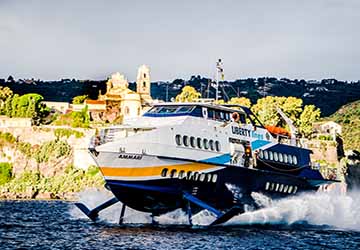
-
Recent Searches
Recent Searches
- Travel Alerts
- My Account
- Customer Service
-
United Kingdom
Vulcano to Filicudi Ferry
The Vulcano Filicudi ferry route connects Aeolian Islands with Aeolian Islands. Currently there is just the 1 ferry company operating this ferry service, Liberty Lines Fast Ferries. The crossing operates up to 21 times each week with sailing durations from around 1 hour 25 minutes.
Vulcano Filicudi sailing durations and frequency may vary from season to season so we’d advise doing a live check to get the most up to date information.
Average Vulcano Filicudi Prices
Prices shown represent the average one way price paid by our customers on this route. Prices shown are per person.
Vulcano Guide
The small Italian volcanic island of Vulcano lies in the Tyrrhenian Sea and is around 25 km to the north of Sicily, and is the most southerly of the eight islands that make up the Aeolian Islands. The island is only around 21 sq. km and its highest point is just under 500 m above sea level. There are a number of volcanos on the island, and includes one of four active, non-submarine, volcanoes in Italy. The most recent volcanic activity is the Gran Cratere at the top of the Fossa cone, the cone having grown in the Lentia Caldera in the middle of the island, and has had at least 9 major eruptions in the last 6,000 years. However, the island's volcanoes have been quiet since around 1890 when Fossa erupted and deposited around 5 meters of pyroclastic material on the summit. The island is also famous for its hot springs which are located a short walk from the harbour. For the brave, visitors are able to walk to the crater of a volcano where you can observe smoke coming out of the ground!
Hydrofoil and ferry services connect Vulcano to the other Aeolian Islands and to Sicily and the mainland. Access from Milazzo in Sicily is convenient, as Vulcano is the boat's first stop from there as they continue to the other islands.
Filicudi Guide
The Italian island of Filicudi is one of the Aeolian Islands and lies off the north east coast of Sicily and is popular with scuba divers. A large part of the volcanic island is now designated as the "Natural Reserve of Filicudi Island". The island is made up of several layers of lava with oldest being located in the sea in front of 'Fil di Sciacca' with the largest being 'Fossa delle felci' and the most recent being 'Montagnola'. The island's slopes tend to be steep and rocky with houses located around the "Porto Pecorini" and "Valdichiesa" where the Church of St. Stephen, the island's patron saint, can be found.
To the north of the island is the spectacular “Punta Zucco Grande” (with ten layers of lava) with the eastern side of the island being a less harsh environment. Perhaps the most beautiful landscapes on the island are the “Punta Perciato” and the giant boulders of the “Rupi delle Sciare” ["Cliffs of the ‘Sciara’”], which are steep vertical cliffs overlooking the sea.


